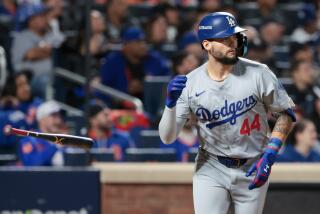Bonilla’s Odyssey to Baseball’s Top Salary
NEW YORK — Bobby Bonilla and his agent, Dennis Gilbert, are tooling up the New Jersey Turnpike in a limousine.
They have just spent the day with officials of the Philadelphia Phillies, who have offered Bonilla a contract that would pay him $25 million over five years. So eager are the Phillies to please Bonilla that they have paid for the car -- even though they know Bonilla is going to meet with a competitor, the New York Mets.
Sixteen days later, with Bonilla within their grasp, the Phillies were less accommodating -- and as a result, delivered Bonilla to the Mets for good. Only a breakdown in negotiations between the Phillies and Gilbert allowed the Mets a last shot at signing Bonilla, which they did Monday by offering $29 million for five years, the richest contract in baseball history.
“The final number was right about where I thought it would be,” Gilbert said. “When I started out I thought it would end up between 25 and 30.”
But the road there was longer and less direct than Bonilla’s chauffeured ride up the New Jersey Turnpike. Depending on what day it was, Gilbert thought the California Angels, Chicago White Sox, Phillies or Mets were the frontrunners to land Bonilla. The leaders changed with the frequency of standings in a tight pennant race.
Bonilla did not state a clear preference about where he wanted to play until 2:30 in the morning of the day he signed last Monday. And then his first choice was Philadelphia. Up until then, Bonilla left his future almost entirely in Gilbert’s hands.
“Teams called, asked for meetings and Dennis took it from there,” Bonilla said. “Dennis has been waiting a long time for this.”
“It went back and forth a lot,” Gilbert said, “but I thought the Angels were the frontrunners most of the time.”
Strangely, it turned out the Angels had little chance of signing him. What’s more, the White Sox did not finish among Bonilla’s top three choices though they offered a staggering -- and complicated -- $35 million, five-year contract. The Mets won the race only because the Phillies would not offer more than $26 million.
This is the story of how those teams wooed Bonilla, the prize of this year’s free-agent crop, and how he came to choose the Mets. The chronology is based on intervmews with Bonilla, Gilbert and several other sources familiar with the negotiations. And it starts even before the free-agent season began:
FRIDAY, OCT. 25
The Atlanta Braves lead the Minnesota Twins, three games to two, on what is an off day for the World Series. Gilbert calls Arthur Schack, counsel for the Major League Baseball Players Association, to say he wants Bonilla and Danny Tartabull, another client, to be the first players to file for free agency. The 15-day filing period does not begin until the day after the World Series ends.
“We pre-registered,” Gilbert says.
MONDAY, OCT. 28
The first team to express interest in Bonilla is the St. Louis Cardinals. St. Louis General Manager Dal Maxvill telephones Gilbert. The White Sox, Angels and Mets soon follow. Clubs may not begin negotiations, however, during the 15-day filing period. “There are several attractive (free-agent) players,” Mets General Manager Al Harazin says, “but he’s in a class by himself.”
TUESDAY, NOV. 12
New York Yankees assistant general manager Bill Bergesch calls Gilbert to say the club has some interest in Bonilla and that General Manager Gene Michael will follow up on the call. That is the last contact between the Yankees and Gilbert.
FRIDAY, NOV. 15
Mets Manager Jeff Torborg, who has a residence in Sarasota, Fla., has lunch with Bonilla, who lives nearby in Bradenton, to discuss various topics.
SATURDAY, NOV. 16
Gilbert and Bonilla lunch with Phillies officials at a suburban Philadelphia country club to which club owner Bill Giles belongs. They then tour other upscale areas outside Philadelphia. They visit with Lenny Dykstra at his home in Devon, where they watch the Florida State-Miami football game.
Dykstra tries to sell Bonilla on the attractiveness of the Philadelphia suburbs, including the quality of their school systems.
The Phillies make an offer of $25 million over five years.
Gilbert and Bonilla then leave for New York, where they have a dinner appointment with the Mets the next day. They travel by limousine. The car is provided by the Phillies.
SUNDAY, NOV. 17
Gilbert and Bonilla meet with Harazin and Frank Cashen at the Peninsula Hotel on Fifth Avene in Manhattan. They are the only diners in the restaurant. “Shows you how much pull the Mets have,” Gilbert says. “They bought out the whole place.”
The Mets do not make an offer in what Harazin calls a “get-acquainted session.” After 2 hours and 45 minutes, Gilbert and Bonilla walk the 14 blocks back to their hotel, the Grand Hyatt.
“Walking back that night on the streets of New York, that’s the first time I really felt Bobby might wind up in New York,” Gilbert says. “Everyone recognized him. Well, maybe not everyone. But a lot of people. They were shaking his hand and wishing him luck. Bobby would stop and have conversations with a lot of them. He seemed real comfortable.”
MONDAY, NOV. 18
Harazin sends a package to the Bonilla house in Bradenton. It includes a Steuben glass apple for Bonilla’s wife, Millie; a Mets jersey with Bonilla’s name and No. 23 on it, and a three-page letter.
“This is for Bobby to see how he looks in a Mets jersey,” it says. “The rest of the uniform is here waiting for him.”
THURSDAY, NOV. 21
The Cardinals drop out. Speaking about Bonilla, Tartabull and Wally Joyner -- a third high-ranked free agent this year -- Maxvill says, “I don’t think any of them are $25 (million) or $30 million guys.”
FRIDAY, NOV. 22
The Mets’ first offer arrives at Gilbert’s office by overnight mail: a five-year proposal that would pay Bonilla $24.5 million, but the fifth year is not guaranteed. It does contain a “trigger clause.” The fifth year would automatically kick in if Bonilla played in 130 games the previous season.
At 9 a.m., Gilbert meets with Angels vice president Whitey Herzog one-on-one at Anaheim Stadium, and then, after Bonilla arrives, with owners Gene and Jackie Autry and vice president Dan O’Brien. They have lunch at Stox, a restaurant near the stadium. Then they visit the Gene Autry Museum.
“That took almost half the day,” Gilbert says. “It was amazing.”
The Angels leave Gilbert with a stunning proposal: a five-year, $27.5 million contract that includes the option for Bonilla to leave as a free agent after the third year.
“After that, I thought Bobby was going to the Angels,” Gilbert says. “It went back and forth a lot, but I thought the Angels were the frontrunners most of the time.”
As it turned out, the Angels were a distant third choice for Bonilla. “It’s like Bobby said, he’s an East Coast kind of guy,” Gilbert says.
The Angels, it was speculated, were merely used to inflate the final price. Indeed, their offer will be used as a guidepost by Gilbert to extract more money out of the Phillies and Mets at the end.
MONDAY, NOV. 25
The Chicago Cubs offer Bonilla a five-year, $25 million contract. Gilbert also sets up a meeting for later in the week with White Sox owner Jerry Reinsdorf, who is eager to show Bonilla the new Comiskey Park. Reinsdorf has put the most lucrative and most complicated offer on the table. It is a five-year deal that is worth $35 million. Reinsdorf, who also owns the National Basketball Association Chicago Bulls, models the contract after the one he gave Michael Jordan.
The contract is loaded with annuities and a split-dollar life-insurance policy, an arrangement in which the ballclub would pay a share of the premiums.
The White Sox offer to take at least $1 million from each annual salary and put it in 10-year bonds and other investments. The White Sox even offer to pick up taxes and fees associated with the investments.
“It was very, very complicated,” Gilbert says. “My background is in insurance. So I understood it. But I don’t think it appealed as much to Bobby. We wanted as much money up front as we could get.”
TUESDAY, NOV. 26
The White Sox name Gene Lamont manager, a move that ms expected to enhance their chances of signing Bonilla. Lamont was a Pirates coach during all of Bonilla’s six seasons in Pittsburgh. “I think our relationship is real good,” Lamont says.
WEDNESDAY, NOV. 27
The Pirates offer Bonilla $22.5 million for five years. Bonilla, who was “95 percent sure” by the end of the season he would leave Pittsburgh, does not even consider it. Later he says he would have signed such an offer if the Pirates presented it in October.
Gilbert calls the Mets and Cubs to say they’ll have to come up with more money. Gilbert’s meeting with Reinsdorf is canceled because of the death of Reinsdorf’s long-time executive assistant.
FRIDAY, NOV. 29
Gilbert says the field is closed. He will allow no other teams to enter the bidding. He says Bonilla will spend the weekend at home weighing the offers and will tell him Monday where he wants to play.
SATURDAY, NOV. 30
Harazin calls Gilbert to improve the Mets’ offer. He adds $1.5 million to the salaries and bonus money, then throws in a guarantee that Bonilla will earn $1.5 million in promotional income in New York. The package guarantees Bonilla $27.5 million.
SUNDAY, DEC. 1
Lamont telephones Bonilla to make one last pitch for the White Sox. Bonilla tells Lamont he is seriously considering the Sox. Lamont telephones Pirates Manager Jim Leyland and says he is optimistic.
Late that night, Bonilla, who is concerned about playing in New York because of family pressures, telephones Willie Randolph, the former Yankee who grew up in Brooklyn. “He was concerned about it,” Randolph says. “I told him it could be tough. It took me a long time to get used to it. You have to learn how to say no. I also told him this could be a great place, probably the best, when you win.”
MONDAY, DEC. 2
Decision day. At 2:30 a.m., Bonilla calls Gilbert.
“It’s time,” Bonilla says. “Let’s get it done. I want to stay on the East Coast. Talk to the Phillies. If you can’t get it done, go to the Mets.”
Bonilla adds that if both deals fall through, he will take the Angels’ offer. He makes a plane reservation to California just in case.
Gilbert starts his day by calling the White Sox to tell them Bonilla has ruled them out.
Gilbert then calls the Phillies. A club source says Bonilla wants Philadelphia because “it’s close to home without exactly being home.”
“The Phillies could have had him right there,” Gilbert says. “It could have been over.”
He tells Giles that Bonilla will sign if the Phillies agree to two changes in their $25 million offer: add $3 million and include a clause that permits Bonilla to leave as a free agent after the third or fourth year.
“It was similar to the Angels’ offer,” Gilbert admits. “But they didn’t know that. Not once did I tell any team what another club had offered. And that was the first time we made a demand.”
The Phillies add $1 million but reject the escape clause.
“We’re going to another team,” Gmlbert tells them. He expects the Phillies to pursue the issue, to come up with more money or something creative to get around the hurdle of the escape clause. But they do not. So Gilbert calls the Mets.
It is 4 p.m. when Gilbert asks Harazin for the escape clause. “Hey, you can always ask,” Gilbert says.
Harazin, after giving it some thought with other club officials, calls Gilbert back and rejects it.
“If we’re going to make a five-year commitment to Bobby,” Harazin says, “we want Bobby to make a five-year commitment to us.”
The conversation ends soon after that. “I thought we might be out of it then, that they were going in a different direction,” Harazin says.
Fifteen minutes later, Harazin’s phone rings. Gilbert is giving the Mets a second chance, apparently because no other East Coast teams in the National League remain.
He gives the Mets two options: agree to the escape clause or come up with more money. The Mets then guarantee the fifth year of their proposal and decide to offer another $1.5 million in salary. The deal is worth $29 million: $27.5 million in salaries and signing bonus, plus the $1.5 million promotional guarantee.
“We decided we were only talking about another $300,000 per year,” Harazin says. “I don’t mean that to sound like $300,000 is not a lot of money, but in a contract like this, it was not as big. Plus, I feel we are not going to have to pay much, if any, of the promotional guarantee.”
The two sides agree to a $1.5 million signing bonus and salaries of $5.5 million, $5.6 million, $5.7 million, $4.7 million and $4.5 million. The Mets had improved their offer by $4.5 million in 10 days.
Harazin then begins working out the contract language with Bonilla’s attorney, Steve Schneider.
At 9:30, Gilbert telephones Bonilla again.
“Bobby, the Mets went for it,” he says.
There is a moment of silence on the line. Later, Gilbert would say, “I think he was in shock.”
“That’s great,” Bonilla says. “You did a wonderful job. We all did.”
Gilbert begins placing calls to Giles, Autry and the other owners to tell them Bonilla had agreed to the Mets’ offer. At 11:30 p.m., Gilbert, Bonilla and Harazin talk to about 40 reporters on a conference call.
Gilbert continues to field calls in his Beverly Hills, Calif., office for another two or three hours. He spends the night there, sleeping on a couch. Bonilla and his wife go right to bed.
“It’s funny,” Millie Bonilla says. “We had so much trouble sleeping with all this going on. But that night we fell asleep right away. I guess from exhaustion, and just knowing that it was over.”
More to Read
Go beyond the scoreboard
Get the latest on L.A.'s teams in the daily Sports Report newsletter.
You may occasionally receive promotional content from the Los Angeles Times.










